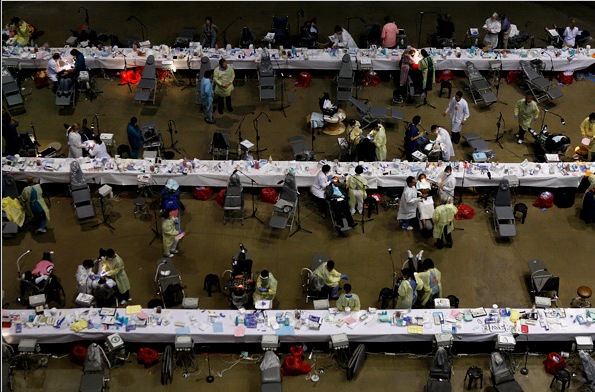The national health care debate has received an enormous amount of attention over the past few weeks, but for the most part the focus has had less to do with the state of health care and more with the incivility of protestors. As President Obama put it, “TV loves a ruckus.” Apparently so too does the print media where most of the photographic record has featured groups of protestors and reformers holding signs and/or shouting at one another, town hall meetings seemingly out of control, and the president addressing audiences in what appears to be stump speech fashion. What we have seen very little of has been any visual evidence that might help us to reflect on the actual problem of the health care system itself.
The difficulty is figuring out how to show a systemic crisis. We can display photographs of individuals in need of some, more, or better health care, but in the very process such images typically individuate the problem in ways that minimize its magnitude (we only see one person or family at a time) and mask its bureaucratic complexities (systems, by their nature, are abstract and multifaceted processes that are rarely evident in the individual case). The photograph below wrestles with these problems.
At first glance it might be hard to know what one is looking at. The photograph is shot from above and at some distance, rather like the way in which we often photograph scenes in which too close proximity to an event might put the photographer at risk of bodily harm. As we will see, the photographer’s well being is not at risk here, and so there must be some other function being served by the photographic aesthetic. The key point to note, however, is that the distance from the scene of action is accentuated by the fact that we get a fairly wide field of vision that frames the image as a landscape: it invites us to take in a wide vista, to see the whole rather than to focus on any individual part—to see the forest rather than the trees. And truth to tell, no individual is recognizable as such; indeed, in most instances it is difficult to identify even typical demographic markers as race and gender with any accuracy. There are individuals here, to be sure, but the significance of their individuality is visually minimized in the face of some larger communal or collective quality—whatever it is that they are doing or whatever it is that has brought them all together.
Here the photograph becomes harder to decipher. And so we need a caption to direct our attention: “Thousands Line Up for Free Health Care.” What we are looking at is not an overhead shot of a flea market or a trade show but a makeshift medical clinic set up inside of The Forum in Inglewood, California by Remote Area Medical, a nonprofit agency that provides free medical and dental care to people living in “remote” parts of the United States and throughout the world. One might not ordinarily think of Los Angeles County as “remote,” but therein lies at least one dimension of the systemic problem of health care in the U.S., for many—by some accounts the number is as high as 46 million citizens or 15% of the population—the issue of access is not a function of geographical proximity to medical care facilities but rather a function of the inability to pay for medical services. And in this instance thousands of people stood in line over night—many for more than one day—in order to “take a number” that would allow them access to medical services that their lack of health insurance would otherwise have made prohibitive. What the story fails to note is that when the numbers ran out many were simply turned away.
Much of the current debate over health care has emphasized the question of choice: will health care or health insurance reform effect the private, individual choice of medical services and practices. And no doubt this is a decisive issue for many people. But as this photograph suggests, if we step back to look at the entire health care system rather than the desires of private individuals, we might recognize that a considerable portion of the national community have no real choices at all.
Its all a matter of what we are able—or willing— to see.
Photo Credit: Ruth Fremson/New York Times

Professor Lucaites,
I was in your C228 class in the fall of 2008 and as I have looked at the debate over healthcare I was reminded of you the other day. One of the key take home messages of your class was that in order to propose public policy you must show that the current state of affairs is so bad that a failure to act carries grave risk or danger. I think this is precisely where the debate over healthcare has been lost with the administration because they did not IMHO do enough to accent the real problems with healthcare in America. As you said, “How do you show a systemic crisis?” Instead the dabate has centered around personal choices, which is not a significant enough issue to warrant diving towards ahem “Socialism.”